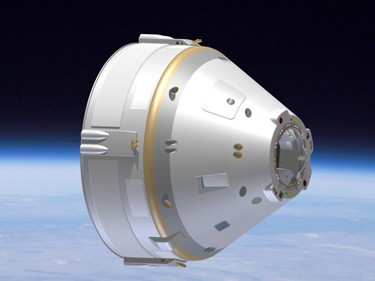Wed, Dec 15, 2010
Spacecraft Resembles Apollo Configuration With Crew And Service
Modules
Boeing has pulled the trigger on its proposal for the second
round of NASA's Commercial Crew Development (CCDev) program. The
company plans to advance the design of its Crew Space
Transportation (CST)-100 spacecraft and Commercial Crew
Transportation System and continue to demonstrate key
technologies.

Boeing Commercial Crew Concept
"In the same way that Boeing helped launch commercial aviation
more than 80 years ago, we are working to develop what could become
a true commercial space transportation system: a commercial service
to take people to the International Space Station and other Low
Earth Orbit destinations," said Brewster Shaw, Boeing Space
Exploration vice president and general manager. "We plan to further
mature our design and continue the development process toward our
first crewed flight in 2015."
The proposal is for an approach that will significantly mature
the CST-100 design through demonstrations of critical subsystems.
The CST-100 spacecraft is designed to support NASA's primary
objective of affordable access to Low Earth Orbit. It will carry up
to seven crew and passengers, is reusable up to 10 times, and is
compatible with a variety of expendable launch vehicles. The
spacecraft -- which is comprised of a Crew Module and a Service
Module -- draws on Apollo-proven aerodynamic characteristics in a
design that uses commercial, off-the-shelf, cost-effective
technologies.

In October, Boeing completed a Systems Definition Review with
NASA that defined the CST-100 spacecraft's system characteristics
and configuration and established a baseline design. Other major
accomplishments of the first round include:
- Design, build and test of a pressurized structure of the crew
module
- Creation of a mock-up of the spacecraft to ensure the crew can
enter and exit the vehicle safely, reach control switches and
easily see through windows
- Demonstration of manufacturability of the base heat shield
structure and thermal protection system to protect the crew during
re-entry into Earth's atmosphere
- Development of an avionics systems integration facility to
support rapid prototyping and full-scale development
- Development of a rendezvous sensor and associated guidance and
navigation software that allows the vehicle to autonomously
approach and dock with the International Space Station and the
planned Bigelow Orbital Space Complex
- Demonstration of airbag land landing, water landing, post-water
landing uprighting and life-support systems.
"We look forward to continuing our joint efforts with NASA to
ensure CCDev's success," said Shaw. "Enabling commercial-crew
access to Low Earth Orbit allows NASA to focus on deep space
exploration and thereby ensure a continued leadership role for the
U.S. in human spaceflight for generations to come."
More News
An Amazing Experience Awaits The Chosen Few... Oshkosh, to us, seems the perfect place to get started on watching aviation recover the past couple of years... and so ANN is putting>[...]
“NBAA has a tremendous responsibility to the business aviation industry, and we are constantly collaborating with them. Our flight departments, professionals and aircraft own>[...]
Dead Reckoning Dead reckoning, as applied to flying, is the navigation of an airplane solely by means of computations based on airspeed, course, heading, wind direction, and speed,>[...]
Aero Linx: Vertical Aviation Safety Team (VAST) We are a public–private initiative to enhance worldwide flight operations safety in all segments of the vertical flight indust>[...]
We're Everywhere... Thanks To You! Even with the vast resources and incredibly far-reaching scope of the Aero-News Network, every now and then a story that should be reported on sl>[...]
 ANNouncement: Now Accepting Applications For Oshkosh 2024 Stringers!!!
ANNouncement: Now Accepting Applications For Oshkosh 2024 Stringers!!! Aero-News: Quote of the Day (06.13.24)
Aero-News: Quote of the Day (06.13.24) ANN's Daily Aero-Term (06.13.24): Dead Reckoning
ANN's Daily Aero-Term (06.13.24): Dead Reckoning ANN's Daily Aero-Linx (06.13.24)
ANN's Daily Aero-Linx (06.13.24) ANN FAQ: How Do I Become A News Spy?
ANN FAQ: How Do I Become A News Spy?




